| diagram | 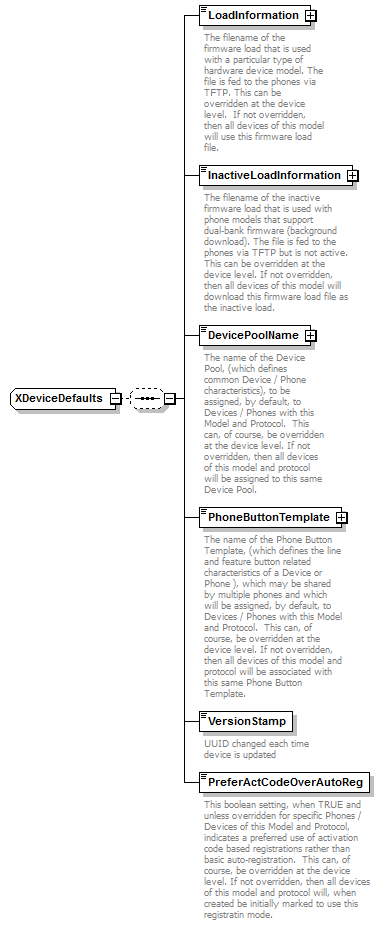 |
| namespace | http://www.cisco.com/AXL/API/15.0 |
| children | LoadInformation InactiveLoadInformation DevicePoolName PhoneButtonTemplate VersionStamp PreferActCodeOverAutoReg |
| source | <xsd:complexType name="XDeviceDefaults"> <xsd:sequence minOccurs="0"> <xsd:element name="LoadInformation" type="axlapi:XLoadInformation" nillable="false" minOccurs="1" maxOccurs="1"> <xsd:annotation> <xsd:documentation>The filename of the firmware load that is used with a particular type of hardware device model. The file is fed to the phones via TFTP. This can be overridden at the device level. If not overridden, then all devices of this model will use this firmware load file.</xsd:documentation> </xsd:annotation> </xsd:element> <xsd:element name="InactiveLoadInformation" type="axlapi:XLoadInformation" nillable="false" minOccurs="1" maxOccurs="1"> <xsd:annotation> <xsd:documentation>The filename of the inactive firmware load that is used with phone models that support dual-bank firmware (background download). The file is fed to the phones via TFTP but is not active. This can be overridden at the device level. If not overridden, then all devices of this model will download this firmware load file as the inactive load.</xsd:documentation> </xsd:annotation> </xsd:element> <xsd:element name="DevicePoolName" type="axlapi:XFkType" nillable="true" minOccurs="1" maxOccurs="1"> <xsd:annotation> <xsd:documentation>The name of the Device Pool, (which defines common Device / Phone characteristics), to be assigned, by default, to Devices / Phones with this Model and Protocol. This can, of course, be overridden at the device level. If not overridden, then all devices of this model and protocol will be assigned to this same Device Pool.</xsd:documentation> </xsd:annotation> </xsd:element> <xsd:element name="PhoneButtonTemplate" type="axlapi:XFkType" nillable="true" minOccurs="1" maxOccurs="1"> <xsd:annotation> <xsd:documentation>The name of the Phone Button Template, (which defines the line and feature button related characteristics of a Device or Phone ), which may be shared by multiple phones and which will be assigned, by default, to Devices / Phones with this Model and Protocol. This can, of course, be overridden at the device level. If not overridden, then all devices of this model and protocol will be associated with this same Phone Button Template.</xsd:documentation> </xsd:annotation> </xsd:element> <xsd:element name="VersionStamp" type="axlapi:String128" nillable="true" minOccurs="1" maxOccurs="1"> <xsd:annotation> <xsd:documentation>UUID changed each time device is updated</xsd:documentation> </xsd:annotation> </xsd:element> <xsd:element name="PreferActCodeOverAutoReg" type="axlapi:boolean" nillable="false" minOccurs="1" maxOccurs="1"> <xsd:annotation> <xsd:documentation>This boolean setting, when TRUE and unless overridden for specific Phones / Devices of this Model and Protocol, indicates a preferred use of activation code based registrations rather than basic auto-registration. This can, of course, be overridden at the device level. If not overridden, then all devices of this model and protocol will, when created be initially marked to use this registratin mode.</xsd:documentation> </xsd:annotation> </xsd:element> </xsd:sequence> </xsd:complexType> |
element XDeviceDefaults/LoadInformation
| diagram | 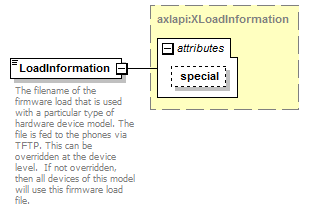 |
||||||||||||
| type | axlapi:XLoadInformation | ||||||||||||
| properties |
|
||||||||||||
| attributes |
|
||||||||||||
| annotation |
|
||||||||||||
| source | <xsd:element name="LoadInformation" type="axlapi:XLoadInformation" nillable="false" minOccurs="1" maxOccurs="1"> <xsd:annotation> <xsd:documentation>The filename of the firmware load that is used with a particular type of hardware device model. The file is fed to the phones via TFTP. This can be overridden at the device level. If not overridden, then all devices of this model will use this firmware load file.</xsd:documentation> </xsd:annotation> </xsd:element> |
element XDeviceDefaults/InactiveLoadInformation
| diagram | 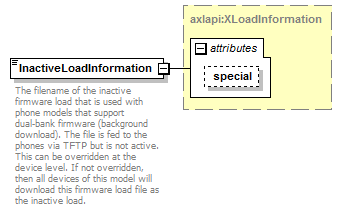 |
||||||||||||
| type | axlapi:XLoadInformation | ||||||||||||
| properties |
|
||||||||||||
| attributes |
|
||||||||||||
| annotation |
|
||||||||||||
| source | <xsd:element name="InactiveLoadInformation" type="axlapi:XLoadInformation" nillable="false" minOccurs="1" maxOccurs="1"> <xsd:annotation> <xsd:documentation>The filename of the inactive firmware load that is used with phone models that support dual-bank firmware (background download). The file is fed to the phones via TFTP but is not active. This can be overridden at the device level. If not overridden, then all devices of this model will download this firmware load file as the inactive load.</xsd:documentation> </xsd:annotation> </xsd:element> |
element XDeviceDefaults/DevicePoolName
| diagram | 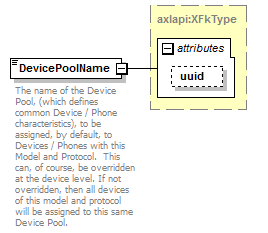 |
||||||||||||
| type | axlapi:XFkType | ||||||||||||
| properties |
|
||||||||||||
| attributes |
|
||||||||||||
| annotation |
|
||||||||||||
| source | <xsd:element name="DevicePoolName" type="axlapi:XFkType" nillable="true" minOccurs="1" maxOccurs="1"> <xsd:annotation> <xsd:documentation>The name of the Device Pool, (which defines common Device / Phone characteristics), to be assigned, by default, to Devices / Phones with this Model and Protocol. This can, of course, be overridden at the device level. If not overridden, then all devices of this model and protocol will be assigned to this same Device Pool.</xsd:documentation> </xsd:annotation> </xsd:element> |
element XDeviceDefaults/PhoneButtonTemplate
| diagram | 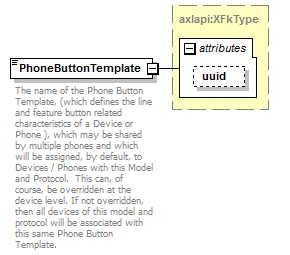 |
||||||||||||
| type | axlapi:XFkType | ||||||||||||
| properties |
|
||||||||||||
| attributes |
|
||||||||||||
| annotation |
|
||||||||||||
| source | <xsd:element name="PhoneButtonTemplate" type="axlapi:XFkType" nillable="true" minOccurs="1" maxOccurs="1"> <xsd:annotation> <xsd:documentation>The name of the Phone Button Template, (which defines the line and feature button related characteristics of a Device or Phone ), which may be shared by multiple phones and which will be assigned, by default, to Devices / Phones with this Model and Protocol. This can, of course, be overridden at the device level. If not overridden, then all devices of this model and protocol will be associated with this same Phone Button Template.</xsd:documentation> </xsd:annotation> </xsd:element> |
element XDeviceDefaults/VersionStamp
| diagram |  |
||||||
| type | axlapi:String128 | ||||||
| properties |
|
||||||
| facets |
|
||||||
| annotation |
|
||||||
| source | <xsd:element name="VersionStamp" type="axlapi:String128" nillable="true" minOccurs="1" maxOccurs="1"> <xsd:annotation> <xsd:documentation>UUID changed each time device is updated</xsd:documentation> </xsd:annotation> </xsd:element> |
element XDeviceDefaults/PreferActCodeOverAutoReg
| diagram | 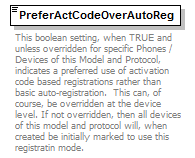 |
||||||
| type | axlapi:boolean | ||||||
| properties |
|
||||||
| facets |
|
||||||
| annotation |
|
||||||
| source | <xsd:element name="PreferActCodeOverAutoReg" type="axlapi:boolean" nillable="false" minOccurs="1" maxOccurs="1"> <xsd:annotation> <xsd:documentation>This boolean setting, when TRUE and unless overridden for specific Phones / Devices of this Model and Protocol, indicates a preferred use of activation code based registrations rather than basic auto-registration. This can, of course, be overridden at the device level. If not overridden, then all devices of this model and protocol will, when created be initially marked to use this registratin mode.</xsd:documentation> </xsd:annotation> </xsd:element> |
XML Schema documentation generated by XMLSpy Schema Editor http://www.altova.com/xmlspy